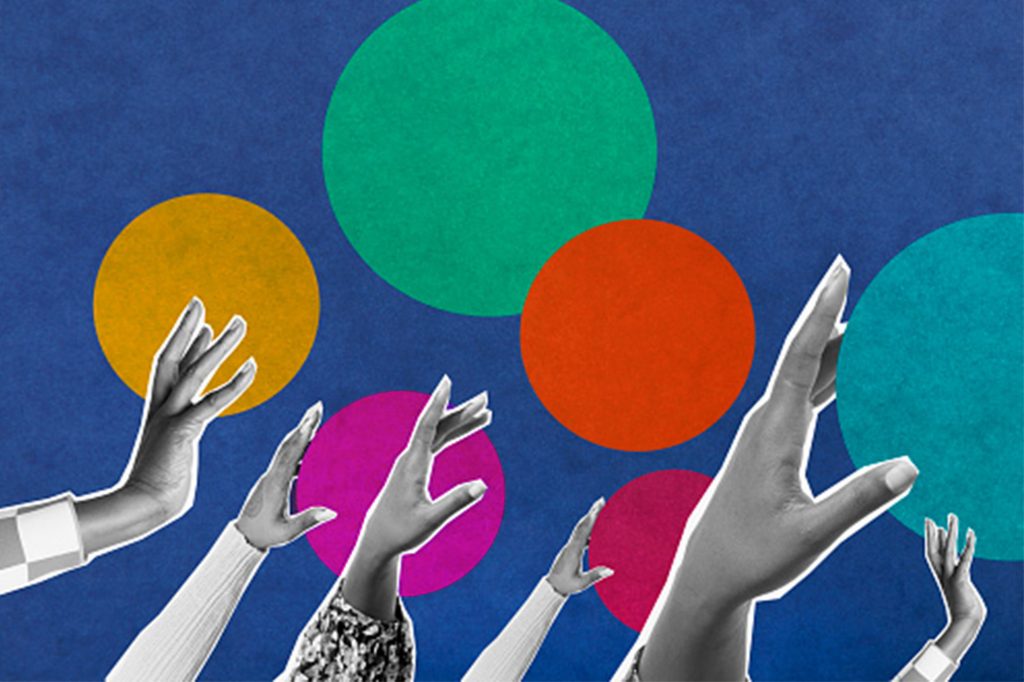Two at a time
Hiring duos is a creative way for companies to build inclusive environments that attract, retain, and nourish people.
Jenny Madorsky is the Senior Vice President and General Manager at Long Dash. She has led operational and digital transformations in the private and public sectors for over a decade. Ankita Callahan is Group Director of Talent & Culture at Long Dash, and formerly led resource management at Huge. She studied Cognitive Psychology at UC Irvine and has a Masters in Organizational Psychology and Business from Aston University.
In our industry of professional services, it’s become clear that “The Great Resignation” is actually a “Great Reshuffle.” People aren’t just leaving their employers, they’re going to other organizations, often competitors. And they’re being drawn to places with cultures that are more diverse, inclusive, and purpose-driven. Our own study, Brand Prism, shows that 74 percent of the workforce feels it is increasingly important to work for a company with strong values.
Since 2020, 61 percent of organizations have shifted focus to prioritize diversity practices in hiring, netting a significant increase in demographic diversity. However, diversity without inclusivity misses the point. Strong person-to-person connections are critical to building inclusion, and McKinsey found that building purpose within a workplace is “deeply intertwined with people who make up an organization.” The reality is that building a more diverse and purpose-driven culture isn’t just about boosting diversity numbers. It’s about building a culture where people value and trust one another.
Sign up for OnBrand
Our weekly digest featuring ideas on the future of brand.
For companies to be on the receiving end of the flux of talent in the Great Reshuffle, now is the time to dream big and rethink how we build our cultures, especially when it comes to recruitment and retention. With the U.S. seeing the largest shuffle of employees on record in the last 10 months of 2021, the stakes are high indeed.
Maintaining the status quo is not going to cut it. Now is the time to rethink how to grow and cultivate our teams, starting with how we hire.
Rethinking the Single Hire
Currently, the most common path to grow a team is to hire an individual with the right range of expertise and experience to fill a business need. During this process, the companies that care about DEI and have strong values will do their due diligence to hire someone who’s a culture add after an extensive talent pipeline review and a rigorous evaluation process. They will take the new employee through a carefully designed onboarding process to build their sense of inclusion and belonging and provide them with tools to set them on the path to successful contribution.
However, even after going through this thoughtful and expensive process, it can take as long as 12 months for new employees to become fully productive team members, according to Gallup’s ongoing workplace surveys. The forming, storming, and norming phases of team development take time, after all, before achieving the coveted performing apex.
What we keep learning over and over again is that teams make for high performance, not individuals. And more importantly, diverse and inclusive teams make for the highest performance.
Duos set the pace and rally everyone else around them to build outward and upward.
So the question becomes: How can companies onboard team members more efficiently, sustainably, and at scale to become fully productive team members? Enter: the duo hire.
Think back to some of the highest performing duos in the recent zeitgeist: Michael Jordan and Scotty Pippin, Coach Lasso and Coach Beard, Amy Poehler and Tina Fey. Each helps the other be their best selves. The Ted Lasso example is most telling here: a duo coming into an unfamiliar game who use their combined experience and talents to harness a team’s latent potential.
Creative duos have been standard throughout history, and in our industry, specifically art and copy duos. Those who hire duos know they can thrust them right into a challenge. These pre-formed teams not only produce ideas quickly, but also work well together to bring the ideas to life. Duos have figured out each other’s strengths and weaknesses, and know how to build each other up to deliver immediately.
In our own company, the two authors of this article have worked together through two different companies and several different roles, forming a duo that delivers operational excellence. When staffing teams to client projects, we also see natural pairings that, after a few engagements together, seem to complete each others’ thoughts and sentences: a technical architect and a user experience (UX) designer, a strategist and a creative director, a client lead and a project manager. All of these pairs, once they hit their rhythm, not only make each other more effective, they make the whole team around them stronger. Think of a dust particle around which ice crystals link up to build a snowflake. Duos set the pace and rally everyone else around them to build outward and upward.
So why not hire that way?
Hiring duos
Imagine a world where instead of posting a job for a single role, we posted for a duo. Yes, it may mean waiting a bit longer as a business to hire a pair instead of just one person, but compared to waiting 12 months for peak productivity, we may be able to achieve it sooner.
With this thought experiment, a few questions come to mind.
1. This is not how the world works today. How do we start?
Not everyone has a work partner, let alone one that would apply with them for a new job. One simple way to start down this path might be to ask individual job candidates during interviews who they’d choose to bring with them if they could and why. If a candidate doesn’t have a work partner that readily comes to mind, ask them to imagine and describe their ideal work partner, including the technical skills and behavioral attributes that best compliment their own skills and traits.
Though a company may not be able to hire two people right away, this shift in hiring practice provides additional insight into what kind of partnership the candidate will need to onboard successfully in a company. At the very least, that person can be partnered with an analogous teammate that strengthens their sense of belonging and trust and ultimately contributes to higher collective performance.
2. Speaking of inclusion: what about DEI? Didn’t we already learn that referral programs are flawed in building up a diverse workforce?
When hiring duos, there is a high probability of hiring a pair of people who have at least a few traits in common, from their background and upbringing to their communication style or other factors. However, without the “I” (inclusion) of DEI, diversity efforts alone tend to fall short. Hiring duos means hiring people that already feel a sense of belonging together. People who are more likely to stick around for each other will work to improve the culture and environment around them to keep each other around. So yes, companies still need to focus on building the right infrastructure to hire duos that add to the diversity of their companies and promote equity once they are hired. But hiring duos with traits in common may help build stronger bonds of inclusion and increase retention of all employees over time.
Hiring duos may seem like a radical departure from the status quo. And the speed at which we make these changes is an important factor to consider—a recent MIT Sloan study shows that higher levels of innovation actually lead to higher rates of employee attrition. If a company innovates too quickly it can burn employees out and leave them behind. The competition for great talent is too fierce for companies to afford to do nothing. Companies should look at hiring duos not as a massive business innovation and departure from the norm, but as a “micro-disruption”—a small change that can have outsized benefits. Hiring duos does require a shift in hiring practices and resourcing decisions. But primarily, it is a way for companies to get creative about how to build truly inclusive, diverse, and thriving environments that attract, retain, and nourish people.





